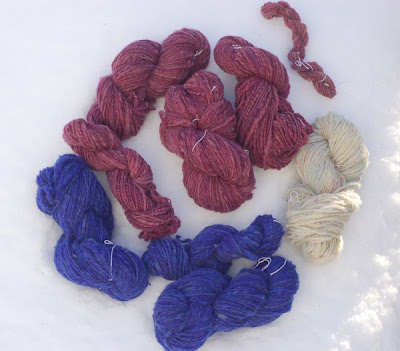
The last few years, I've made an effort to make my fiber supplies more compact. I've sorted and used scrap fabrics in big projects and small. After visiting a going-out-of-business sale, I haven't had to buy yarn since 1992 (although I swapped work for a huge horde of dyeable New Zealand wool last summer.) I don't really need to go on a fiber diet anymore; in fact, I need to find sources to buy fabric for clothing and upholstery, and I've run very short of hand-dyed fabrics.
I do have a backlog of dyed, carded fleeces waiting to be spun, however. Since the first of the year, I've been spinning a little bit every day, and these are the results. These fleeces are from local sheep, Suffolk-Dorset crosses raised in pastures full of burdock. With short cuts, mats, neps and plenty of "vegetable material," most hand-spinners throw stuff like this away, but I always need to find out what I can do with the materials at hand.
I picked over these fleeces as best I could, washed them in Dawn dishwashing detergent in garbage cans in the back yard, and dried it outdoors. Then I picked the locks open and threw away more short cuts and burdock seed heads. I dyed the wool in an old crockpot. My technique involved dissolving Jacquard Acid Dye in a small amount of water, pouring it in the crockpot, and stuffing in as much wet wool as possible, finally adding enough water to cover. (This over-stuffing makes the dye take unevenly, giving a nice, heathery effect in the spun wool.) After the water and wool got hot and had simmered for an hour, I added 1/4 to 1/2 cup of white vinegar from the grocery store, and let the wool simmer until all the dye came out of the water and went into the wool. It's easy to tell when acid dyes are exhausted--the water clears!
The great thing about dyeing this sort of dirty wool before carding and spinning is that the burdock, dirt, and other vegetable materials fall out more easily, and you don't have to wonder what zoonoses you might pick up from the sheep.
After the wool dried, I carded the colorful locks on my drum carder, making bats. At this point, one can blend colors, but the uneven dyeing technique actually makes this unnecessary.

2 comments:
Your post makes me:
* Want to watch and help while you prep and dye wool.
* Lie down and take a long restful nap.
And here I was, feeling a little overloaded about doing errands, laundry and more school studying today...
;-)
Wish you were here! It's a messy process, and you can't tell how things will turn out. Not everyone thinks that's a recipe for fun, but clearly we both do.
Post a Comment